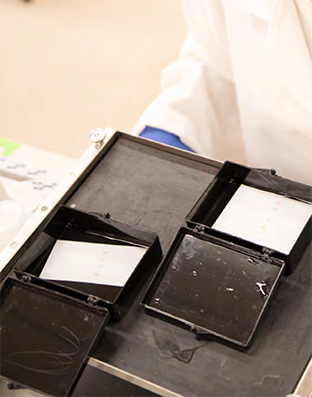
"I have used a wide variety of secondaries and Jackson ImmunoResearch has consistently been the best. The fluorophores are bright and stable and their selective (x reactivity removed) secondaries have always shown species specificity in multiple labeling."
Janet Duerr, Ohio UniversityRating: 5.0
We provide a range of reagents to optimise immunotechniques including Normal Serums, Bovine Serum Albumin and ChromPure™ Purified Proteins. These reagents can be used either for blocking, to minimise unwanted background signal, or as controls for experimental validation. Our blog article on selecting controls and blocking reagents provides a detailed overview.
ChromPure proteins are primarily used as experimental controls for either primary or secondary antibodies. They are available conjugated to a range of fluorescent dyes and reporter enzymes, allowing the isolation of signal derived from non-specific interactions. ChromPure purified proteins may also be used as blocking reagents for Western blotting, IHC, and IF.
Normal serums are obtained from non-immunized animals and consequently do not detect any specific antigen. Normal serum is recommended for use as a blocking agent to reduce background from non-specific, conserved- sequence, and/or Fc-receptor binding.
Gamma globulins are derived from non-immunized animal serums and have been further purified by salt fractionation, ion-exchange chromatography, and gel filtration. Gamma globulins can be used as blocking reagents and as controls. View our product list here.
Bovine serum albumin (BSA) is used extensively as a carrier protein to dilute antibodies and as a general protein blocking agent in immunoassays and immunodetection protocols.
Fab fragments can enable the blocking of endogenous immunoglobulins to reduce background staining and for multiple labeling assays when primary antibodies are derived from the same host species. Learn more with our blocking protocols.
Cautions: When using a labeled secondary antibody for detection, never block with normal serum or IgG from the host species of the primary antibody. If immunoglobulins in normal serum bind to the specimen of interest, they will be recognized by the labeled secondary antibody, resulting in higher background.
Bovine serum albumin (BSA) and dry milk, both commonly used for blocking, may contain bovine IgG. With the exception of bovine anti-goat IgG, many secondary antibodies such as anti-bovine, anti-goat, anti-horse and anti-sheep will react strongly with bovine IgG. Therefore, use of BSA or dry milk for blocking or diluting these antibodies may significantly increase background and/or reduce antibody titer. For blocking, use normal serum (5% v/v) from the host species of the labeled secondary antibody.

Blocking reagents and controls may be required for experimental protocols depending on the immunotechniques undertaken. Here we detail a selection of common problems solved with appropriate blocking, diluents or control reagents.
| Problem | Solution | Indicated Product |
|---|---|---|
| Background (non-specific signal obscuring bands of interest) | Use appropriate blocking reagent to block membrane prior to incubating with primary. | Normal Serums |
| BSA (IgG- and protease-free) | ||
| Avoid using milk or BSA if primary antibodies are derived from goat, horse or sheep. | Normal Serums | |
| Detection of reduced immunoprecipitating (IP) antibody at 50 or 25 kDa | To avoid detecting IP antibody heavy chains at 50 kDa, use conjugated anti-light chain specific antibody. | Anti-light chain specific antibodies |
| To avoid detecting IP antibody light chains at 25 kDa, probe blot with conjugated anti-IgG, Fc fragment after blocking with monovalent Fab fragment anti-Fc. | Whole IgG Antibodies | |
| Fab fragments |
| Problem | Solution | Indicated Product |
|---|---|---|
| Confirmation that primary antibody binding is due to antigen specificity | To demonstrate specific binding of the primary antibody, use an isotype negative control (nonspecific IgG from the same species as the primary antibody). | ChromPure™ proteins |
| Background (general) | Block endogenous binding sites which may interact with experimental reagents. | Normal Serums |
| Background (homologous Ig recognition) | Block endogenous immunoglobulins. | Fab Fragments |
| Multiple label primary antibodies from same host species | Utilize Fab fragments in suggested protocols to accomplish multiple labeling. | Fab Fragments |
| Immunolabel primary antibody prior to incubation. | FabuLight | |
| Endogenous enzymes | Inactivate endogenous peroxidase with hydrogen peroxide. | Selecting Control, Diluent and Blocking Reagents Guide |
| Use levamisole to inactivate endogenous phosphatases. | ||
| Endogenous biotin | Block endogenous biotin. | Incubate with streptavidin, followed by free biotin. |
| Ionic interactions | Include detergent in buffers, optimize salt concentrations and pH. | Tween®‑20 and/or Triton™ X‑100. |
| Problem | Solution | Indicated Product |
|---|---|---|
| Background from antibodies binding Fc receptors. | Block Fc receptors. | Normal Serums |
| Use F(ab')2 format secondary antibody to avoid entrapment by Fc receptors. | F(ab')2 Secondary Antibodies | |
| Confirmation that primary antibody binding is due to antigen specificity | Use an isotype negative control (non-specific IgG from the same species as the primary antibody) to demonstrate specific binding of the primary antibody. | ChromPure™ Purified Proteins |
| Problem | Solution | Indicated Product |
|---|---|---|
| Background | Use an appropriate blocking reagent to block wells prior to incubating with the primary antibody. | Normal Serums Page |
| BSA (IgG-free and protease-free) | ||
| No Signal | Use a positive control to demonstrate activity of the labeled secondary antibody: coat with primary antibody isotype and detect directly with secondary. | Chrompure Proteins |